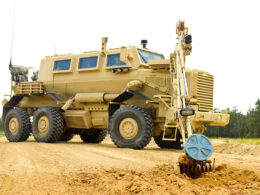Forbes says Moscow’s forces are preparing for a decisive combat phase in Russia’s Kursk Oblast, as they continue to replace lost heavy equipment with simpler, wheeled armored vehicles. This shift comes after significant losses, with Russian regiments in the region losing hundreds of pieces of heavy equipment since Ukraine’s strong offensive that started in early August.
According to reports, a Ukrainian marine corps drone company, stationed in western Russia’s Kursk Oblast, destroyed 22 Russian vehicles in November. The losses occurred during a skirmish on 1 December, when Russian airborne forces attempted to charge Ukrainian positions.
“Three Russian BMD-2s (infantry light fighting vehicles, – Ed.)… were stopped by mines that were placed by my company,” said Kriegsforscher, a drone operator with the unit. The BMD-2s were later destroyed by artillery and FPV drones.
The skirmish marks just one chapter in a wider ongoing battle in the Kursk salient. Since the Ukrainian invasion of the area in early August, Russian forces have suffered significant losses, with Ukrainian forces destroying 364 pieces of Russian heavy equipment between 6 August and 26 November. These losses include tanks, infantry fighting vehicles, and trucks. Ukrainian losses, on the other hand, were slightly lighter, with 319 vehicles lost during the same period.
As Russia counterattacks to eliminate the Ukrainian-held salient, which stretches over 650 km² of western Kursk Oblast, its tactics are changing. With a deadline set by President Putin to secure a victory in the region by February 2025, the Russian military has begun increasing its focus on replacing the massive losses of tracked vehicles, which are more difficult to produce and maintain.

Instead, the Russian army has started deploying more wheeled vehicles, such as the Tigr and Typhoon armored trucks. These are simpler, lighter, and easier to produce, but offer less protection and firepower compared to the heavier, tracked vehicles they replace, Forbes noted.
This strategy comes as a response to the dire situation facing Russian forces in Kursk. Following a series of Ukrainian successes, particularly in October and November when Russian President Putin ordered an intensified effort to reclaim the salient, the battle is expected to escalate. Kriegsforscher described the latest attacks as a “warm-up before the show,” warning that Russia’s coming assaults would likely be more intense and unpredictable.
While Russian losses in Kursk have been catastrophic, the new emphasis on wheeled vehicles could present significant tactical challenges. Unlike tracked BMP-2s, which are highly mobile in rough terrain like mud and snow, wheeled trucks are limited to roads, making them more predictable for Ukrainian forces operating drones and artillery, Forbes says.
- Related:
- Forbes: Predictable Russian tactics in Kursk salient play into Ukrainian defenses
- Frontline report: Russian commanders’ lies about gains in Kursk Oblast leave soldiers trapped
- FT: Ukraine’s Storm Shadow strike injures North Korean general, kills several officers in Russia’s Kursk Oblast
- ISW: Ukrainian military denies North Korean presence in Kharkiv Oblast
- Storm Shadow strike kills Russian general in Russia’s Kursk Oblast, source claims
- Nearly 580,000 Russian soldiers fighting against Ukraine
- Reuters: Nearly 11,000 North Korean troops deployed in Russia’s Kursk Oblast








